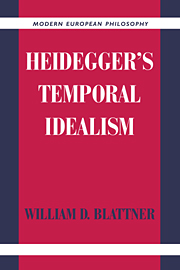Book contents
- Frontmatter
- Contents
- Acknowledgments
- A Note on Sources
- Introduction. Ontology, Phenomenology, and Temporality
- 1 Care as the Being of Dasein
- 2 Originary Temporality
- 3 World-Time and Time-Reckoning
- 4 The Ordinary Conception of Time and Disengaged
- 5 Heidegger's Temporal Idealism
- Conclusion. The Consequences of the Failure of Heidegger's Temporal Idealism
- Bibliography
- Index
1 - Care as the Being of Dasein
Published online by Cambridge University Press: 05 June 2012
- Frontmatter
- Contents
- Acknowledgments
- A Note on Sources
- Introduction. Ontology, Phenomenology, and Temporality
- 1 Care as the Being of Dasein
- 2 Originary Temporality
- 3 World-Time and Time-Reckoning
- 4 The Ordinary Conception of Time and Disengaged
- 5 Heidegger's Temporal Idealism
- Conclusion. The Consequences of the Failure of Heidegger's Temporal Idealism
- Bibliography
- Index
Summary
What is Dasein? In the first sentence of the first section of the first chapter of division 1 of Being and Time, Heidegger offers a referential definition of “Dasein”: “We in each case ourselves are the entity whose analysis is our task” (S&Z, p. 41). But what is it about us that makes us a distinctive phenomenon? What characteristics make us a kind? Heidegger lists two in the next two sentences: “The being of this entity is in each case mine. This entity, in its being, comports itself to its being” (ibid.). These two characteristics subsequently get the names, respectively, “mineness” and “existence.” To a large extent, the exploration of mineness is delayed until division 2, whereas the systematic development of existence, as well as its relatives and dependents, occupies Heidegger's efforts in division 1.
In this chapter, I explore existence and its siblings, facticity, falling, and discourse. These four phenomena make up the crucial concept of “care” – the term that replaces “existence” as a more specific and developed name for the being of Dasein. Each of these elements of care will in turn be linked with a series of other terms: “existence” with “understanding,” “projection,” and “ability”; “facticity” with “affectivity,” “attunement,” and “import” (although this last term is not Heidegger's); “falling” with “being-amidst” and “concern”; and “discourse” with “language.” In sifting through the detailed account of the sorts of entity we are, the account painted by these terms and their connections, we shall be able to depict what Heidegger takes to be the essential features of a normal, or “everyday,” human being.
- Type
- Chapter
- Information
- Heidegger's Temporal Idealism , pp. 31 - 88Publisher: Cambridge University PressPrint publication year: 1999

